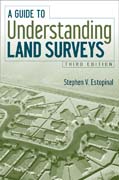
This basic introduction clearly explains the functions and procedures required in every survey (routine or otherwise), why it is done, and how it is accomplished. Readers will not only gain an appreciation for a survey, plat, or landdescription but will be able to evaluate it in its proper perspective, realize any inherent inadequacies or discrepancies that may exist, and have a much better idea of when a survey is needed to solve a problem or to obtain an approval. With a wealth of high-quality line drawings, this new edition has been expanded with 30% new material and fully updated to current practice and technology, including the use of GPS and GIS in land surveys and how technology should be interpreted in evaluating the quality and accuracy of a land survey. INDICE: PREFACE. 1 PURPOSE OF THE BOOK. 2 REAL PROPERTY ON A ROUND PLANET.2.1. Ownership. 2.2. Title. 2.3. Boundaries. 2.4. Deed. 2.5. Identifying Boundaries. 2.6. Corners. 3 GEOMETRY. 3.1. Plane Geometry. 3.2. Land Point. 3.3. Land Line. 3.4. Straight Land Line. 3.5. Plumb Line. 3.6. Level. 3.7. Land Distances. 3.8. Elevation. 3.9. Land Area. 3.10. Horizontal Angles. 3.11. VerticalAngles. 3.12. Degrees, Minutes, and Seconds. 3.13. Maps or Plats. 4 DEFINING NORTH. 4.1. True North. 4.2. Astronomic North. 4.3. Magnetic North. 4.4. Assumed North. 4.5. Grid North. 4.6. Directions. 4.7. Azimuths. 4.8. Bearings. 5 PROJECTION SYSTEMS. 5.1. Projectionless Maps. 5.2. Tangent Plane Projections. 5.3. Advantages of Tangent Plane Systems. 5.4. Disadvantages of Tangent Plane Systems. 5.5. State Plane Projections. 5.6. Advantages of State Plane Projections. 5.7. Disadvantages of the State Plane Projection. 6 FUNDAMENTALS OF MEASUREMENTS. 6.1. Accuracy and Precision. 6.2. Implied Precision. 6.3. Errors. 6.4. All Measurements Include Errors. 6.5. Reduction of Errors. 6.6. Development ofStandard Procedures. 6.7. Colonial Period. 6.8. PostCivil War Period. 6.9. Beginning of the Modern Period. 7 LAND RECORD SYSTEMS. 7.1. Metes and Bounds System. 7.2. U.S. Public Land System (USPLS). 7.3. Platted Subdivision or Urban Systems. 8 THE GLOBAL POSITIONING SYSTEM (GPS). 8.1. Overview. 8.2. Fundamentals. 8.3. GPS and Land Surveys. 8.4. CORS Networks. 8.5. Practical Application. 8.6. Strengths. 8.7. Weaknesses. 8.8. Coping with Reality. 9 THE GEOGRAPHIC INFORMATION SYSTEM (GIS) REVOLUTION. 9.1. Building a Foundation. 9.2. Sources ofInformation. 9.3. System Maintenance. 9.4. Potential Users. 9.5. Potential for Misapplication. 10 BOUNDARY RECOVERY. 10.1. Rules of Evidence. 10.2. Sourcesof Evidence. 10.3. Office Procedure. 10.4. Field Procedure. 10.5. Rendering aDecision. 10.6. USPLS Boundary Recovery. 10.7. Metes and Bounds Boundary Recovery. 10.8. Platted Subdivision Boundary Recovery. 11 EVALUATING SURVEY PLATS.11.1. Plat Evaluation Checklist. 11.2. Determining the Land Record System Used. 11.3. Determining the Map Projection Used. 11.4. Evaluating the Age of the Survey. 11.5. Determining the Purpose of the Survey. 11.6. Examining the Survey for Gross Discrepancies. 11.7. North Arrow. 11.8. Legal Description. 11.9. Date of the Survey. 11.10. Name of the Surveyor. 11.11. Signature and Seal. 11.12. Adjoining Properties. 11.13. Dimensions of All Sides. 11.14. Bearing or Angles. 11.15. Name of Client, Purpose of Survey. 11.16. Certification. 11.17. Limiting Words or Phrases. 11.18. Area. 11.19. Scale. 11.20. Comparing the Survey Plat with the Deed. 11.21. Examining the Survey Plat for Easements. 11.22. Examining the Survey Plat for Encroachments. 11.23. Determining the Precision Required. 11.24. Determining Needs Not Covered in a Survey Plat. 11.25. Contacting the Surveyor. 12 EXERCISES IN EVALUATING SURVEY PLATS. 12.1. The Case of the Three Partners. 12.2. The Land Grabber. 12.3. Easement Surprise. 12.4. Excessive Problems. 12.5. Metes Meets Bounds. 12.6. The Square That Wasnt There. 13 WRITING LEGAL DESCRIPTIONS. 13.1. Creating New Parcels. 13.2. Existing Parcels. 13.3. General Outline. 13.4. The Caption. 13.5. The Narrative. 13.6. Key Phrases. 13.7. Deletions or Additions. 13.8. References. 14 EXERCISES IN WRITING DEED DESCRIPTIONS. 14.1. Case 1. 14.2. Case 2. 14.3. Case 3. 15 ETHICS AND PROFESSIONAL CONDUCT15.1. Confidentiality. 15.2. Professional Courtesy. 15.3. Impartial Evaluation. 15.4. Promote Professionalism. APPENDIX OF TABLES. GLOSSARY. INDEX.
- ISBN: 978-0-470-23058-9
- Editorial: John Wiley & Sons
- Encuadernacion: Cartoné
- Páginas: 272
- Fecha Publicación: 05/02/2009
- Nº Volúmenes: 1
- Idioma: Inglés
